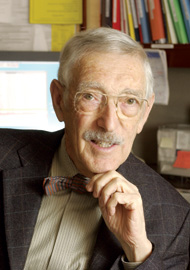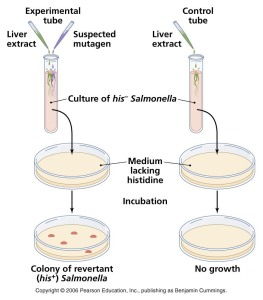When it became apparent that cancer could be triggered by certain chemicals, a way was needed to check such chemicals before they were approved for use. The Ames test was developed in the 1970s by Prof. Bruce Ames, Professor of Biochemistry at UC Berkeley. The Ames test is a fast and sensitive assay of the ability of a chemical compound or mixture to induce mutations in DNA. Because the assay does not use a live animal model, it is inexpensive, easy, and fast.
Bruce Ames was one of the early heroes of environmentalism. After he discovered that Tris-BP, a flame-retardant in children’s pajamas, caused mutations in the Ames Test, he helped environmentalists three decades ago in their successful campaign to ban Tris-BP — one of the early victories against synthetic chemicals.
Bruce Ames published his work in a series of papers, including “Identifying Environmental Chemicals Causing Mutations and Cancer” in the journal Science (volume 204, 1979). Dr. Ames‟ work was critical in linking mutations in DNA to carcinogenesis. His work identified many mutagens including pesticides such as DDT, the food additive AF-2 (no longer used), the flame retardant “tris-BP” used in children’s pajamas, and many other mutagenic compounds including those previously found in hair dyes.
Professor Ames continued his research into mutagenicity and to link this to oxygen radicals, with the result that his 1983 paper on this subject has attracted 2,400 citations (Science, 221: 1256-64). His 1993 paper on the role of these radicals in the degenerative diseases of ageing has been referenced nearly 3,500 times (Proc. Natl. Acad. Sci. USA, 90: 7915-22).
In 1987, Ames and his collaborator Lois Gold ranked natural and synthetic pesticides and found that cancer risks from traces of pesticide residues on fruits and vegetables are minuscule compared with the cancer-causing potential of some natural chemicals in plants. “We wrote a review pointing out that every plant has a hundred or so toxic chemicals—nature’s pesticides—to kill off insects, animals, and other predators, and that we were getting 10,000 times more of them than [of] man-made pesticides.
Still, everybody is buying expensive organic food,” says Ames. “It’s the new religion. We won the scientific battle but we lost the public-relations battle.” For that work and more, arguing that traces of synthetic chemicals are not a cancer risk, Ames and Gold have been criticized as being in the pocket of the pesticide industry, despite never accepting money, consulting with industry companies, or testifying in trials.
Among Bruce Ames greatest achievements:
Creating the Ames test (an assay to determine if a chemical is mutagenic)
Created a comprehensive database of carcinogen potency.
Showed that many nutrient deficiencies cause DNA damage and proposed the triage theory as a mechanism by which this occurs.
Developed a nutrient-rich fruit bar designed to improve metabolism and prevent age-related disease.
Uncovered a mechanism linking vitamin D–deficiency to serotonin synthesis, autism, and brain dysfunction
In a landmark research article published in the Proceedings of the National Academy of Sciences, Bruce Ames and his colleagues found that “99.99 percent (by weight) of the pesticides in the American diet are chemicals that plants produce to defend themselves. Only 52 natural pesticides have been tested in high-dose animal cancer tests, and about half (27) are rodent carcinogens; these 27 are shown to be present in many common foods.”
“About 99.9 percent of the chemicals humans ingest are natural. The amounts of synthetic pesticide residues in plant food are insignificant compared to the amount of natural pesticides produced by plants themselves. Of all dietary pesticides that humans eat, 99.99 percent are natural: they are chemicals produced by plants to defend themselves against fungi, insects, and other animal predators.
We have estimated that on average Americans ingest roughly 5,000 to 10,000 different natural pesticides and their breakdown products. Americans eat about 1,500 mg of natural pesticides per person per day, which is about 10,000 times more than the 0.09 mg they consume of synthetic pesticide residues.”
Even though these natural chemicals are as likely to be carcinogenic as synthetic ones, it doesn’t follow that they’re killing us. Just because natural pesticides make up 99.99 percent of the pesticides in our diet, it doesn’t follow that they’re causing human cancer — or that the .01 percent of of synthetic pesticides are causing cancer either.
Ames’ experiments demonstrated that “Natural and synthetic chemicals are equally likely to be positive in animal cancer tests. We also conclude that at the low doses of most human exposures the comparative hazards of synthetic pesticide residues are insignificant.”
In other words, consumers who buy overpriced organic foods in order to avoid pesticide exposure are focusing their attention on 0.01% of the pesticides they consume. Think about that for a moment… While there’s pandemonium about parts per billion amounts of synthetic pesticide residues on our food, there are more concentrated compounds in vegetables and fruits actually known to cause cancer. In addition, some of the more commonly used pesticides in agriculture have mechanisms of action that are specific to the pests their targeting and don’t effect mammals, making them far safer than many natural pesticides, which is on reason why they’ve gained popularity in the past half century.
“Everything you eat in the supermarket is absolutely chock full of carcinogens. But most cancers are not due to parts per billion of pesticides. They’re due to causes like smoking, bad diets and, obesity.” – Dr. Bruce Ames.

